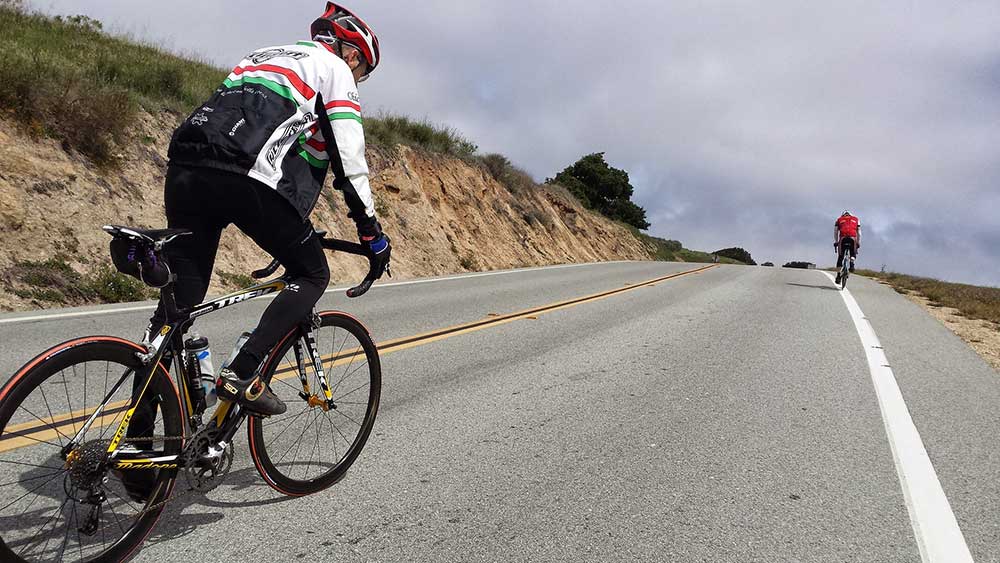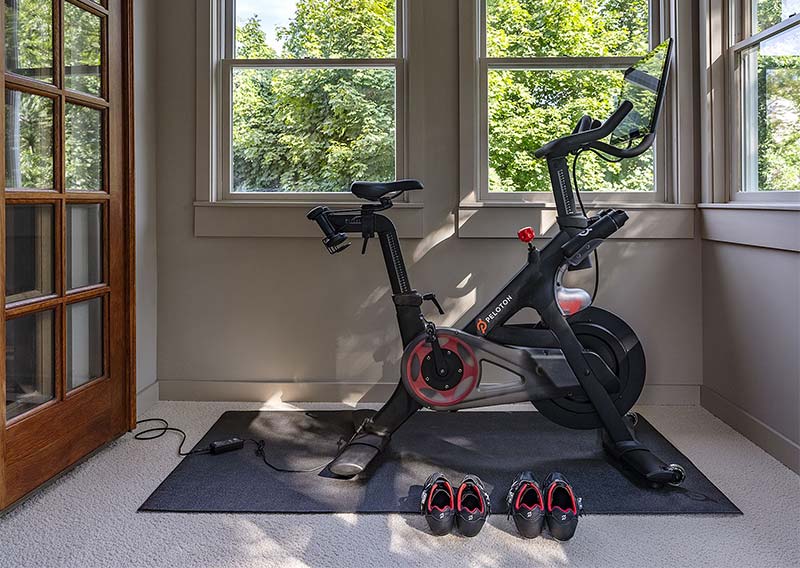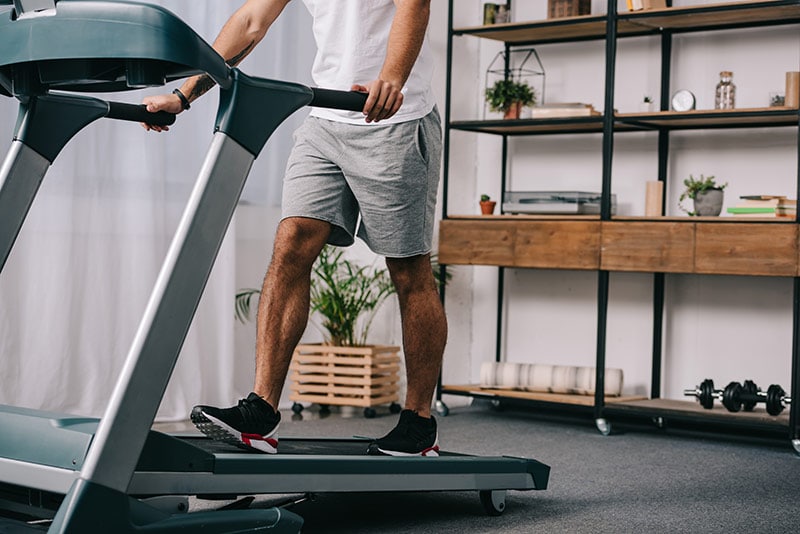Whether you want to cycle for fun or as a serious sport, you’ll eventually have to climb a hill or two out there.
Uphill cycling, in contrast to cycling on flat or downhill roads, requires tremendous stamina and motivation.
That’s why it’s so important to put in additional time at the gym climbing hills in preparation for challenges and races, so you won’t bonk when you finally reach one.
Exercises to do on and off your regular bike are discussed below to help you build endurance and speed for uphill cycling.
How to Train for Uphill Cycling in the Gym

Without using your actual bicycle, one of the best ways to train for an uphill course is to hit the gym.
There you will find many machines that will help you develop the insane amount of endurance you may someday need to tackle a large hill on the course.
Here are just a few of the machines you can use to accomplish this goal, along with some of the exercises you can employ on each machine.
Recumbent Stationary Bicycle
The recumbent stationary bicycle is one of the best ways to develop both the leg strength and endurance needed to breeze through the uphill sections of any course.
On a recumbent stationary bike, as the name suggests, you actually sit on a wide saddle that is equipped with a high backing for reclining or sitting upright.
The pedals, which are very ergonomic and usually come with feet straps, lie in front of you as you sit and pedal.
These highly technical machines allow you to train on a variety of course types, including those that specialize in hilly or mountainous terrains.
These courses may seem very difficult at first, but once you begin to develop your endurance, they tend to get easier and easier as time goes on.
Before you know it, you will be pedaling along inclines like they were flat ground, making this machine one of the perfect training partners for developing hill skills.

Upright Stationary Bike
For a truly authentic session of training, you will definitely want to try out the upright stationary bike.
The upright stationary bike resembles an actual bike and usually comes with a wide seat, comfort-grip handlebars, tacky ergonomic pedals with foot straps, and a wide variety of programs to choose from—just like the recumbent bike.
One of the best things about using the stationary recumbent bike to train is that you can ride either on the saddle or standing up, just as you would on a hilly section of your course.
What’s more, you can either use the handlebars for balance or recline forward, much like you would do if you were drafting.
With programs that include “hills” “fat burning” and “endurance,” the stationary upright bike is how most of the world’s best cyclists train for uphill performance.
Stair Climber
Uphill rides can be murderous on the muscles in the legs and your bottom (or glutes).
Fortunately, there is a really great machine that can help strengthen all of these muscles while also vastly improving your endurance and wind.
This machine is the stair climber, one of the most popular machines in any gym for those looking to strengthen and tone their leg muscles.
The stair climber machine is like a standard flight of stairs on steroids.
Those who use this machine can get a superb aerobic workout, one that also trains the muscles in the quads, calves, hamstrings and glutes.
It truly is the perfect machine for building the leg strength necessary to tackle big hills on your ride.
Treadmill

Although the treadmill is not a “cycling” machine per se, it can help you to vastly increase your stamina while also building up your legs and glutes.
Treadmills can be set to inclines up to 15 percent, and when walking up these inclines you’ll get a great workout that raises the heart rate, burns fat, and increases your wind.
Including an uphill session on the treadmill during your workout can give you the endurance you need for almost any activity, and by the time you are through you will also notice a nice burn in the muscles of the leg and glutes.
Other Ways to Train for Uphill Climbing
In this section we will explore alternate ways to train for the hills—methods and techniques you will perform outside of the gym.
Some of these will involve your bike, such as riding hill repeats, while others will involve things knowing the ride and understanding your own limitations.
Ride Hill Repeats
If you ask any professional cyclist about his or her training regimen, odds are most will say that hill repeats are a major component.
So, how do hill repeats work.
Actually, the term is pretty self-explanatory.
Riders will be expected to ride out to a local climb—a hill that usually takes them between 30-seconds to 10-minutes to normally climb.
The actual size of the hill that you will use to ride these repeats should be based on the specific hill or hills for which you are ultimately training.
When you get to your desired climb, the trick to training is to ride up that hill with maximum endurance—whatever your maximum happens to be at this point—and recover on the ride back down.
Once you reach the bottom of the incline, you will repeat that process and continue to repeat it for about 9 more times.
This may sound grueling—and in some respects it is—but as you continue to return to your desired hill for repeat riding you will ultimately find that those climbs start to get easier and easier each time you ride them.
This is your body and muscles adapting to the hilly conditions.
The increased resistance that is offered by a hill translates to short climbs, about 30 seconds in duration, that provide an outstanding muscle-building regimen.
These ascents are also perfect for improving your sprinting and short burst power.
If the climbs you’re targeting are longer, then you can look for a 10- 15-minute ascent, riding at around 80 to 90 percent of your maximum heart rate (or power), with equal times for recoveries.
If you live in an area that simply has no hills, you are not completely out of luck.
In cases such as these, instead of using the hill as the primary means of resistance, you can use your gears instead to create a kind of “ghost hill.”
Just pedal in a very high gear for the appropriate amount of time and then switch back to a low gear for your recovery.
Understand Your Climb
Let’s face it, nobody wants to be the guy who begins the uphill climb in an all-out sprint, just to fade one minute into the ride.
Because of this, to properly train for a specific uphill climb you must first know and understand all of the information associated with that climb.
Only then can you train proportionately for what you may be up against in competition.
Understanding your climb can be enormously helpful when it comes to things like pacing and technique.
For example, if you know where the steepest parts of the hill are, you can gear down a little earlier than the competition, thus giving you a distinct advantage.
If the hill in question is indeed part of a race in which you will be participating, try to make the climb beforehand and even ride a few hill repeats at the very spot for which you are training.
If pre-climbing the hill is not realistic, try to get as much information on the uphill section as you can, such as the distance, elevation, and the average gradients for each mile/kilometer.
This way, you will understand when to back off and when to prepare for steeper sections.
Prepare Nutritionally
Finally, because the steep parts of a course require more energy than others to tackle, it might be wise to fuel up at the bottom of the incline with a little nutrition.
This, of course, goes to the question of knowing yourself and understanding your body’s requirements.
However, if it has been a while since you last ate, and you are heading into a particularly lengthy climb, it is critical that you give yourself a good shot of energy at the base of the hill before you start that climb.
By refueling at the bottom of the hill you can give both your muscles and your mind a great boost of energy right before they truly need it.
Additionally, eating at the bottom of a long uphill traverse is always much easier than trying to do it climbing uphill, especially if you have turned hypoxic from the lack of air and energy.
Training in the gym, riding hill repeats and understanding the ride and the rider will give you a much better chance to tackle any uphill course section like a champ.
